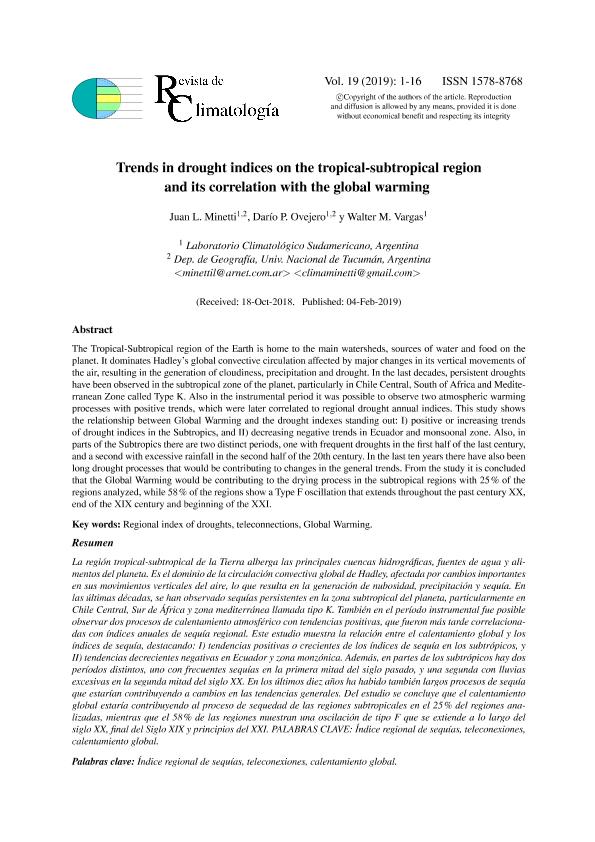Mostrar el registro sencillo del ítem
dc.contributor.author
Minetti, Juan Leonidas

dc.contributor.author
Ovejero, Dario Pedro

dc.contributor.author
Vargas, Walter Mario

dc.date.available
2022-07-15T19:30:43Z
dc.date.issued
2019-02
dc.identifier.citation
Minetti, Juan Leonidas; Ovejero, Dario Pedro; Vargas, Walter Mario; Trends in drought indices on the tropical-subtropical region and its correlation with the global warming; Revista de Climatología; Revista de Climatología; 19; 2-2019; 1-16
dc.identifier.uri
http://hdl.handle.net/11336/162250
dc.description.abstract
The Tropical-Subtropical region of the Earth is home to the main watersheds, sources of water and food on the planet. It is the domain of the Hadley’s global convective circulation, affected by major changes in its vertical movements of the air, resulting in the generation of cloudiness, precipitation and drought. In the last decades, persistent droughts have been observed in the subtropical zone of the planet, particularly in Chile Central, South of Africa and Mediterranean Zone called Type K. Also in the instrumental period it was possible to observe two atmospheric warming processes with positive trends, which were later correlated to regional drought annual indices. This study shows the relationship between Global Warming and the drought indexes standing out: I) positive or increasing trends of drought indices in the Subtropics, and II) decreasing negative trends in Ecuador and monsoonal zone. Also, in parts of the Subtropics there are two distinct periods, one with frequent droughts in the first half of the last century, and a second with excessive rainfall in the second half of the 20th century. In the last ten years there have also been long drought processes that would be contributing to changes in the general trends. From the study it is concluded that the Global Warming would be contributing to the drying process of the subtropical regions in 25% of the regions analyzed, while 58% of the regions show a Type F oscillation that extends throughout the past century XX, end of the XIX century and beginning of the XXI.
dc.description.abstract
La región tropical-subtropical de la Tierra alberga las principales cuencas hidrográficas, fuentes de agua y alimentos del planeta. Es el dominio de la circulación convectiva global de Hadley, afectada por cambios importantes en sus movimientos verticales del aire, lo que resulta en la generación de nubosidad, precipitación y sequía. En las últimas décadas, se han observado sequías persistentes en la zona subtropical del planeta, particularmente en Chile Central, Sur de África y zona mediterránea llamada tipo K. También en el período instrumental fue posible observar dos procesos de calentamiento atmosférico con tendencias positivas, que fueron más tarde correlacionadas con índices anuales de sequía regional. Este estudio muestra la relación entre el calentamiento global y los índices de sequía, destacando: I) tendencias positivas o crecientes de los índices de sequía en los subtrópicos, y II) tendencias decrecientes negativas en Ecuador y zona monzónica. Además, en partes de los subtrópicos hay dos períodos distintos, uno con frecuentes sequías en la primera mitad del siglo pasado, y una segunda con lluvias excesivas en la segunda mitad del siglo XX. En los últimos diez años ha habido también largos procesos de sequía que estarían contribuyendo a cambios en las tendencias generales. Del estudio se concluye que el calentamiento global estaría contribuyendo al proceso de sequedad de las regiones subtropicales en el 25% del regiones analizadas, mientras que el 58% de las regiones muestran una oscilación de tipo F que se extiende a lo largo del siglo XX, final del Siglo XIX y principios del XXI. PALABRAS CLAVE: Índice regional de sequías, teleconexiones, calentamiento global.
dc.format
application/pdf
dc.language.iso
eng
dc.publisher
Revista de Climatología
dc.rights
info:eu-repo/semantics/openAccess
dc.rights.uri
https://creativecommons.org/licenses/by-nc-nd/2.5/ar/
dc.subject
REGIONAL INDEX OF DROUGHTS
dc.subject
TELECONNECTIONS
dc.subject
GLOBAL WARMING
dc.subject.classification
Investigación Climatológica

dc.subject.classification
Ciencias de la Tierra y relacionadas con el Medio Ambiente

dc.subject.classification
CIENCIAS NATURALES Y EXACTAS

dc.title
Trends in drought indices on the tropical-subtropical region and its correlation with the global warming
dc.type
info:eu-repo/semantics/article
dc.type
info:ar-repo/semantics/artículo
dc.type
info:eu-repo/semantics/publishedVersion
dc.date.updated
2022-07-15T14:54:21Z
dc.identifier.eissn
1578-8768
dc.journal.volume
19
dc.journal.pagination
1-16
dc.journal.pais
España

dc.description.fil
Fil: Minetti, Juan Leonidas. Consejo Nacional de Investigaciones Científicas y Técnicas; Argentina. Laboratorio Climatológico Sudamericano; Argentina. Universidad Nacional de Tucumán. Facultad de Filosofía y Letras. Departamento de Geografía; Argentina
dc.description.fil
Fil: Ovejero, Dario Pedro. Laboratorio Climatológico Sudamericano; Argentina. Universidad Nacional de Tucumán. Facultad de Filosofía y Letras. Departamento de Geografía; Argentina
dc.description.fil
Fil: Vargas, Walter Mario. Consejo Nacional de Investigaciones Científicas y Técnicas. Oficina de Coordinación Administrativa Ciudad Universitaria; Argentina. Laboratorio Climatológico Sudamericano; Argentina
dc.journal.title
Revista de Climatología
dc.relation.alternativeid
info:eu-repo/semantics/altIdentifier/url/http://www.climatol.eu/reclim/
Archivos asociados
